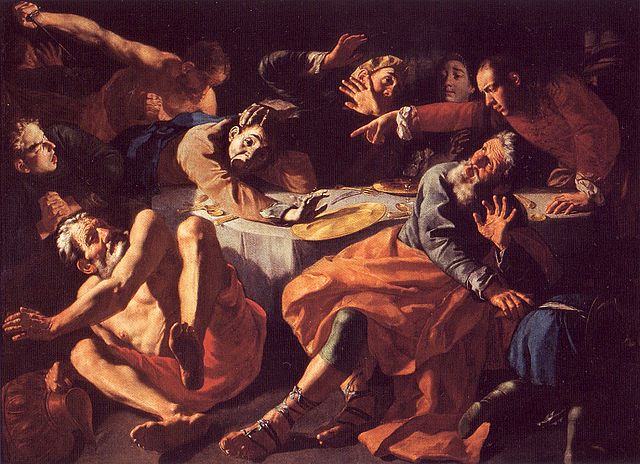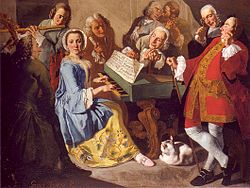Top Qs
Timeline
Chat
Perspective
Gaspare Traversi
Italian painter From Wikipedia, the free encyclopedia
Remove ads
Gaspare Traversi (February 1722 – 1 November 1770) was an Italian Rococo painter best known for his genre works. Active mostly in his native city of Naples, he also painted throughout the Italian peninsula, including a stay in Parma.
Remove ads
Biography
Summarize
Perspective
Early life and education
Gaspare appears to have been born to a Genoese merchant living in Naples.[1] He appears to have been baptized on February 15, 1722, in the church of Santa Maria dell'Incoronatella in Naples under the name Gasparro Giovanni Battista Pascale Traversa. He trained under Francesco Solimena. He was a contemporary of other Solimena pupils, Giuseppe Bonito (1707–1789), also a genre painter, and Francesco de Mura (1696–1784).
Early career
Traversi’s early works, while still indebted to Solimena, already reveal a deep and highly individual realism, for example Job Derided (National Museum in Warsaw), the Portrait of a Man (L’Aquila, De Agostini Dragonetti, priv. col.) and The Schoolmaster. The Schoolmaster, with three-quarter-length figures in a compressed and uneasy space, established the format and subject-matter of his later pictures of contemporary life. In such pictures he transcended the limitations of genre painting: his lucid, at times merciless, portrayals of local people satirize the social aspirations of the emergent bourgeois class in southern Italy.

From 1752 Traversi spent a great deal of time in Rome, from this date onwards apparently residing alternately there and in Naples. In 1752 he painted a series of six canvases for the Roman Basilica of Saint Paul Outside the Walls, in which he interpreted biblical and apocryphal subjects as scenes from everyday life. Among these paintings is the powerfully realistic Feast of Absalom, a turbulent composition characterized by startling contrasts of light and dark and by figures whose dramatic gestures and expressions of pain and fear recall the art of Caravaggio and Ribera.
In Rome one of his major clients was Raffaello Rossi da Lugagnano, a leading member of the Franciscan order. The many religious paintings he commissioned from Traversi include five scenes from the Passion (1753; Galleria nazionale di Parma), sent to the convent of Castell'Arquato; the fourteen Stations of the Cross, sent to the church of San Rocco in Borgo Val di Taro, near Parma; and the Pentecost, painted in 1757 for the church of San Pietro d'Alcantara, Parma.
An awareness of Traversi’s work thus spread beyond central and southern Italy, revealing his similarity to northern Italian painters, such as Giacomo Ceruti and Fra Galgario, who were also concerned to restore the 17th-century naturalist tradition. In their fuller, more rounded and classical forms these religious works suggest that Traversi was interested in the art of Marco Benefial, while their chiaroscuro and naturalism recalls the style of the Venetian Giovanni Battista Piazzetta, some of whose drawings and paintings he may have known.
Years of maturity

In this mature period, from c. 1752 into the 1760s, Traversi was producing genre paintings, sometimes sending them from Rome to Naples with his brother Francesco. These include some of his most powerful and savage works: The Concert and the Secret Letter (both Naples, Banco di Napoli, on dep. Naples, Capodimonte); the Drawing Lesson and the painting usually called Concert ‘a voce sola’ (both Kansas City, Nelson-Atkins Museum of Art); The Fortune-teller, which revives one of the most popular Caravaggesque themes, and the Love Letter (both Naples, priv. col.). His famous Portrait of a Man (1760; Naples, Museo di Capodimonte) and the penetrating and vigorous portrait of Raffaello Rossi da Lugagnano (two versions: Rome, priv. col.; Bologna, Cassa di Risparmio) are fine examples of his ability to portray strong-willed character and to suggest a social type. Among his last works are the Portrait of a Canon (1770; New York, Paul Ganz priv. col.), Judith (Genoa, priv. col.), the Blind Beggar (London, Cowper Cooper priv. col.) and the Old Pedant (Rome, priv. col.). He left no pupils, yet his art was widely influential, particularly on the work of Lorenzo de Caro, on the genre paintings of Giuseppe Bonito and on certain paintings by Orazio Solimena and Giovanni Battista Rossi.[2] Traversi was a focus of a monograph by Roberto Longhi.
Remove ads
Legacy
Traversi can be described as a Neapolitan Hogarth, Steen or Longhi, working in a Caravaggist style. Traversi's satirical paintings typically depict animated groups of bourgeois protagonists that seem compressed physically into an indoor pictorial space that can barely contain them.[2] Even his religious canvases have foreshortened crowding. Facial expressions are lively and varied; some of the characters, often children, stare at the viewer. Women are often situated in either a foolish or ironic situation, or engage in a pulchritudinous talent, while men leer or participate with other intentions in mind. One could view these as elaborations of moralistic tales, such as Caravaggio's The Fortune Teller, a topic which Traversi also depicted, but Traversi's living rooms are more densely populated, and the emotions, as well as the situations, teeter awkwardly with imbalance.
Remove ads
Gallery
- The Seduction
- Surgeon inspects Wound
- Sitting for Portrait
- Reading a Letter
- Old beggar with Urchin
- The old beggar
- St. Margaret of Cortona
- A concert
- Portrait of Sir Thomas Saunders Sebright
- Judith with Head of Holofernes
- Teasing a Sleeping Girl
Partial anthology of works
Remove ads
Notes
References
External links
Wikiwand - on
Seamless Wikipedia browsing. On steroids.
Remove ads













